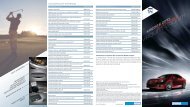zoo}-zoo} - Longueuil Mazda
zoo}-zoo} - Longueuil Mazda
zoo}-zoo} - Longueuil Mazda
Create successful ePaper yourself
Turn your PDF publications into a flip-book with our unique Google optimized e-Paper software.
3Unique SituationAs recently as mid-2007, many experts believed that the crisis would be contained withinthe arena of mortgage issuers who had overloaded on subprime loans. Few would havepredicted that the subprime fallout would be so severe as to threaten the economy to theextent that it has thus far.While downturns in the mortgage and housing markets have caused economic problemsbefore, experts explain that the current situation is unique. In a 2007 interview, Susan M.Wachter, professor of real estate and finance at Wharton, University of Pennsylvania,said that in the past such events have created downturns in the overall economy through acredit crunch in the banking sector. This would be the first time downturns are driven bya credit crunch in the non-banking sector of finance.ROOTS OF THE SUBPRIME CRISISThere are a number of theories as to what led to the mortgage crisis. Many experts andeconomists believe it came about though the combination of a number of factors in whichsubprime lending played a major part.Housing BubbleThe current mortgage meltdown actually began with the bursting of the U.S. housing“bubble” that began in 2001 and reached its peak in 2005. A housing bubble is aneconomic bubble that occurs in local or global real estate markets. It is defined by rapidincreases in the valuations of real property until unsustainable levels are reached inrelation to incomes and other indicators of affordability. Following the rapid increases aredecreases in home prices and mortgage debt that is higher than the value of the property.Housing bubbles generally are identified after a market correction, which occurred in theUnited States around 2006. Former Chairman of the Federal Reserve Board, AlanGreenspan, said in 2007 that “we had a bubble in housing,” and that he “really didn’t getit until very late in 2005 and 2006.”Freddie Mac CEO Richard Syron agreed with Greenspan that the United States had ahousing bubble and concurred with Yale economist Robert Shiller’s 2007 warning thathome prices “appeared overvalued” and that the necessary correction could “last yearswith trillions of dollars of home value being lost.” Greenspan also warned of “largedouble digit declines” in home values, much larger than most would expect.________________________________________________________________________________________________© 2008, CCH. All rights reserved.














